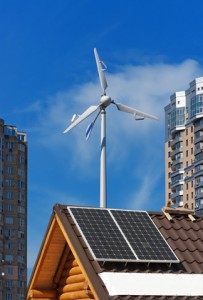Whether or not one believes global warming is an issue to be concerned about, it’s hard to refute the evidence that the world’s carbon dioxide production is the main cause of the warming of our planet. To slow the effect, more individuals and corporations are doing their part to minimize their carbon footprint.
Recent advancements in and an explosion of research on alternative, or renewable, energy are making it possible for homeowners to lessen the impact of their energy usage. Increasingly, there are more options that provide comparable or better performance to current energy sources.
Three of the more common renewable energy sources are solar power, wind power and hydro power. Note that while these are “more common,” they are not necessarily widely used in homes … yet.
Solar power is exactly as it sounds: power that comes from the sun. By the same token, wind power comes from the wind. Hydro power comes from the force of moving water. This article focuses on solar energy.
Determining solar power for homes
By various estimates, sunlight can meet the energy needs of the entire human population many times over. Imagine, using the sun’s energy to heat your home, take hot showers, power up all your electronic gadgets and kitchen appliances and keep your lights on!
There are, of course, heavy initial costs involved to using solar power to run your house. At the same time, there are ways you can use the sun’s energy for many years without a long-term expense.
If you’re building a new home, work with your designer to make the most use of the sunlight that falls on your lot. For example, place doors and windows where they’ll work best for you. If you live in a cooler climate, don’t put windows on the shady side. Also in this environment, avoid high ceilings unless you absolutely must have them (they are really nice to have, just keep in mind that you’re heating a lot of space you don’t use).
In warmer temps, plan for the back of the house to get the hottest sun of the day and put fewer windows on the hotter sides.
If you’re in an existing home, plant trees and perennial bushes near doors and windows. During the summer the growth will keep your house cool and in the winter the bare branches will let the sun in. You might also board up windows on the “wrong” side of the house or use insulated window coverings.
For either a new home or existing one, consider installing a solar power water heater. It can be a big expense initially, but you’ll recover the cost through energy savings within 10 years. Even if you don’t plan to be in your house that long, having a solar power water heater will add to your home’s value at the time of sale.
Installing a solar power system
There are a variety of factors to consider when researching solar energy for your home. How much you intend to use it will determine how many solar panels you’ll need. If you’re going completely off the grid, i.e., independent of your local power company, you’ll obviously need more than if you continue to use supplemental power.
Another factor is where to put the system. Rooftops are the logical choice, but since solar energy systems are designed to last for several decades, will your roof hold up that long? (Much solar power installation happens with new construction.) If not, you could mount the panels on poles, on a shed or on the ground.
As with any purchase, you’ll want to shop around for your solar power system and interview a few installers to make sure you’re comfortable with the product and service you’re getting. The outfit you buy it from may offer installation or at least have suggestions for reputable installers. Another option is the ever-increasing “do-it-yourself” project.
For an in-depth look at solar energy technologies, go to the Department of Energy website.
Why is solar power a great way to save money?
Sunlight is free! It’s really as simple as that in the long-term. But as indicated earlier, the short-term, up-front costs can be steep.
One way to reduce your costs is to do it yourself. Build your own panels and install them with a little help from your friends. It does seem like a daunting task, but it is possible and more people are turning to this solution.
One D-I-Y’er offers a number of articles and insights on building and installation.
IMPORTANT: Before you commit to a system, be sure to check with your city or county government permitting office to ensure your system meets current laws such as zoning and height restrictions. Better yet, know what they are before you even begin the process!
Is it true that solar power = no pollution?
Not entirely. There are the fumes associated with manufacturing, transporting and installing solar power systems. Once in place, however, they don’t contribute to acid rain or urban smog! You can be assured that your energy system is much better for the environment all around.
A word of caution: while a solar power system doesn’t emit pollution once installed, its efficiency can be affected if used in heavily polluted areas.


Getting set up with solar power is a bit tricky and you really have to study it. But worth once understood.
Good post. Will keep an eye out for other articles by you. Have you got a weekly newsletter I can check out? Regards
Solar infrastructure in the UK has come to a grinding stop as the government reduce the Feed-in-Tariff to half it was previously, leaving our green indsutry in tatters struggling for survival amidst what is going to be radical job losses and reduction in our green credentials.
Thanks a lot for helping me 🙂 !
I have to write an article in my class about this theme, thanks for the insights.
Good work. Askin’ for more. 🙂